A Huge Shift is Coming to America
January 23rd, 2014 // 10:00 am @ Oliver DeMille
We entered a new cycle of history during 2013.
Like any cycle, this one started small. But it is growing quickly, and it is already swaying the future.
To understand this, let’s briefly go back to the beginning — when this cycle was first described.
In 1836, even before Alexis de Tocqueville finished his famous classic, Democracy in America, a British official named Henry Taylor published a book entitled The Statesman.
Taylor’s main point was that the Anglo world had been focused on forms of government for too long, ever since 1787 when the Americans wrote their Constitution. Taylor noticed that that there are two main types of political leadership:
- Setting up forms and systems of government (statesmanship)
- The business of governing (politics)
The first, which consists mostly of writing and discussing what is the best constitution or model of government, is always led by statesmen.
The second, which consists of day-to-day politics that focus on the issues, is dominated by political parties, special interest groups, politicians, and bureaucratic agencies.
The first usually emphasizes freedom and liberty, while the second is all about increasing government spending and regulations.
Statesmanship vs. Politics
In 1836, Taylor’s message was that Europe and America had spent sixty years focused on the first kind of leadership, and he argued that it was time, in his words,
“to divert the attention of thoughtful men from forms of government to the business of governing.”
It was statesmanship versus politics, and Taylor believed that it was time to forget statesmanship for a while and emphasize politics. The era of the politician had come.
Specifically, the statesmanship era from 1776 to 1836 was followed by an era of politics from 1836 to 1913, which was followed by an era of statesmanship (changing constitutions and overarching societal systems) from 1913 to 1945. Then came another era of politics (increased government spending and regulations by politicians and bureaucrats) from 1945 to 2013.
We are on the verge of another major shift today, and the changes will be drastic.
Instead of the major national dialogue focusing on issues (e.g. immigration, abortion, energy policy, national security, health care, gun control, education policy, etc.), the increasing focus will be on how to change the Constitution.
It has already started, in fact. Less than a year ago, for example, Georgetown professor Louis Seidman wrote an article in the New York Times entitled “Let’s Give Up on the Constitution.” He argued that the Constitution is outdated, and that it is time to “scrap” it and write something better.
This brought a series of angry rebuttals from the Right, and a number of strong suggestions from the Left, but few seem to realize that this is the beginning of a new era of the American debate.
Several others have entered this growing discussion, like David Brooks, who wrote in the New York Times on December 12, 2013 that the U.S. should alter our system to “Strengthen the Presidency.”
And New York Times bestselling author Mark Levin wrote a series of new amendments that he feels should be added to the Constitution to fix our current system and get America back on track.
Just a couple weeks ago, almost 100 legislators from 32 states met in Mount Vernon, Virginia to discuss the possibility of adding amendments to the constitution through a convention of the states, as authorized by Article 5 of the constitution.
The Next Shift
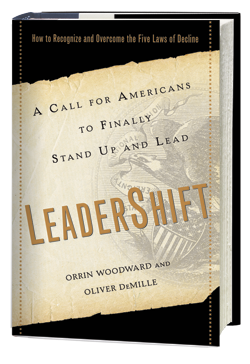 When Orrin Woodward and I wrote the New York Times bestseller LeaderShift and released it earlier this year, neither of us knew that 2013 would be the year of this major shift — from politics to statesmanship, from issues to changing the whole system.
When Orrin Woodward and I wrote the New York Times bestseller LeaderShift and released it earlier this year, neither of us knew that 2013 would be the year of this major shift — from politics to statesmanship, from issues to changing the whole system.
This is momentous, and our book outlines nine specific changes, in the form of proposed amendments to the U.S. Constitution, that would put American prosperity, freedom, strength and power quickly back on line.
I am convinced that LeaderShift is representative of the best of this new trend, this growing debate on how to change our system to get it headed in the right direction once again. And you can read all four of the new commentaries in this emerging debate (Seidman, Levin, Brooks, Woodward and DeMille) and decide for yourself.
Make no mistake: this is THE debate of the coming decade. As a nation, we have concluded that Washington is broken. The American people generally feel that the system is fractured and needs to be fixed, and those who are focused on daily governing will miss out on the real tide ahead: coming changes in our overall system.
Since such changes aren’t usually the focus in elections, many people won’t realize that this is happening. But as I already noted, the debate has already begun.
Issues and Politics
When Orrin and I were interviewed by many journalists about our book, it was a bit of a surprise to us that nearly every interviewer wanted to focus on issues, issues, issues and partisan politics, politics, politics.
That’s been the tone in America for over sixty years, so we probably should have expected it.
But now the tide is shifting. This isn’t something we can afford to get wrong. Change is upon us. President Obama was elected by promising such change. Yet if we make the wrong changes, it can only hurt this great nation.
Change is here, and it is the kind of change that focuses on our Constitution and the very fundamentals of our society and national system.
The debate will grow in the years ahead, the way such changes always do — slowly for a while, and then all at once.
Yet the ideas at the center of this debate, the ideas right now argued by Seidman, Brooks, Levin, Woodward and DeMille, and others who join the discussion, will sway the 21st Century.
I wrote in my book, 1913, that the year 1913 was a pivotal time of change. It looks more and more like its century year 2013 will be even more significant. This is the year we began the shift from politicians, bureaucrats and issues to and major changes to our Constitution and system.
Some will argue that we should change nothing, that the old Constitution is the best. But in reality we haven’t been following the original principles of the Constitution for many decades, and the primacy of the Constitution continues to erode due to the way Washington skirts, reinterprets and at times ignores it.
Whatever you think of our current system, change is imminent. The only question is: How will we change, what precisely will we change?
That is what this debate is all about. A LeaderShift is happening, right now, under our noses. America is changing while its citizens sleep.
What we need is a new generation of Madisons, Adams, and Jeffersons.
We need more men and women who understand how to write constitutions and amendments that create and protect real freedom. If you are one of these people, or should be, it is time to join the debate.
It is time to take action, so we go in the right direction.
 Oliver DeMille is the New York Times, Wall Street Journal and USA Today bestselling co-author of LeaderShift: A Call for Americans to Finally Stand Up and Lead, the co-founder of the Center for Social Leadership, and a co-creator of TJEd.
Oliver DeMille is the New York Times, Wall Street Journal and USA Today bestselling co-author of LeaderShift: A Call for Americans to Finally Stand Up and Lead, the co-founder of the Center for Social Leadership, and a co-creator of TJEd.
Among many other works, he is the author of A Thomas Jefferson Education: Teaching a Generation of Leaders for the 21st Century, The Coming Aristocracy, and FreedomShift: 3 Choices to Reclaim America’s Destiny.
Oliver is dedicated to promoting freedom through leadership education. He and his wife Rachel are raising their eight children in Cedar City, Utah.
Category : Blog &Business &Citizenship &Constitution &Economics &Education &Entrepreneurship &Generations &Government &History &Politics
It’s Time for Optimism and Leadership
January 10th, 2014 // 10:00 am @ Oliver DeMille
It’s time for optimism in America. Right now.
I’m convinced that the best era of America is still ahead. And it’s time to start building it, even if Washington won’t, and even if the politicians are going to bring us both ups and downs in the years ahead.
When we turn on the news, we hear of debts ceilings, a $17 trillion national debt, deficits, credit rating downgrades, inflationary money, layoffs, political party anger and name-calling, leaders who won’t negotiate, government shutdowns, sequesters, defaults, international unrest and conflicts, and on and on.
It’s a bit overwhelming, and most people are either deeply frustrated or have decided not to follow the news too closely.
But this is only part of the story.
While those in Washington argue, over and over, about their latest Crisis of the Month, a lot of regular citizens have done something very important. They’ve realized that the future is up to them, and not to the politicians.
And the numbers of such people are growing. Some are getting more involved than ever before at the local level, and others are spending more time strengthening their families. Some are studying current events with real passion, and others are tackling history and the great classics in order to learn a lot more.
Still others are focusing on community projects, service, teaching the youth, and supporting charities that really need more support, and quite a few are increasing their entrepreneurship — building the economy for themselves and others instead of waiting for politicians to get their act together.
And make no mistake, when the regular people in America, Canada, and other nations realize that it’s up to them and then take action, it’s like rousing a sleeping giant. When the average citizen stands up and gets involved, like after Pearl Harbor or during the American Revolution, big things really happen.
Right now, the giant is just starting to stir. The signs are faint, but they are growing: Tea Partiers, Occupiers, protestors, bloggers, radio-show callers, “social medi-ers,” and above all, lots of newly-focused volunteers and entrepreneurs.
The people are beginning to feel the need to take their nation back, especially their economy. The future is bright.
Whatever Washington does, the leadership spirit in our homes will determine the years and decades ahead. Many experts have dubbed the 21st century “the China Century,” but in truth the reason China is growing is widespread entrepreneurship. That’s the real story.
And up until now, most freedom-lovers have argued that American entrepreneurs will bring back our economy — if Washington will just get out of the way. This message is now changing.
As the problems in politics keep increasing, more and more people are looking around, taking stock, and saying, “You know what? Washington might never get its act together. So, I guess it’s up to me.”
This is the spirit of enterprise, and there is almost no power in the world as strong as a people fully committed to free enterprise.
This is an exciting time. Instead of waiting for the politicians to free up the economy, we’re now making the great FreedomShift: Regardless of what Congresses and Presidents and Justices do, let’s build our families, communities, and the economy to a whole new level — and show Washington what to do. We’re the leaders now. When we lead, the politicians will have to follow.
If you haven’t joined this movement yet, today is a good time to start.
Build a business.
Or read a great classic.
Start a class for kids in your area.
Or begin attending all your city council meetings.
Make and follow a plan to double your savings rate.
Brainstorm. Identify where your passions are, and then take action to genuinely improve your life and the world around you.
Get started. The economy and society need you. It’s up to us.
What the media and politicians don’t realize is that this is happening. The worse Washington gets, the more people are taking personal action. It’s real. And it’s growing. Whatever Washington does, this is the movement that will make or break our future.
Smile. Laugh with a friend. Tell your kids a joke and giggle together. Tell them that the future is bright. And take action to make it true.
Now is a time for real optimism.
 Oliver DeMille is the New York Times, Wall Street Journal and USA Today bestselling co-author of LeaderShift: A Call for Americans to Finally Stand Up and Lead, the co-founder of the Center for Social Leadership, and a co-creator of TJEd.
Oliver DeMille is the New York Times, Wall Street Journal and USA Today bestselling co-author of LeaderShift: A Call for Americans to Finally Stand Up and Lead, the co-founder of the Center for Social Leadership, and a co-creator of TJEd.
Among many other works, he is the author of A Thomas Jefferson Education: Teaching a Generation of Leaders for the 21st Century, The Coming Aristocracy, and FreedomShift: 3 Choices to Reclaim America’s Destiny.
Oliver is dedicated to promoting freedom through leadership education. He and his wife Rachel are raising their eight children in Cedar City, Utah.
Category : Blog &Economics &Education &Family &Generations &Government &Leadership &Liberty &Mini-Factories &Politics
The Only Two Ways to Fix Washington
January 9th, 2014 // 10:00 am @ Oliver DeMille
 Washington is broken, and the problem is short-term thinking.
Washington is broken, and the problem is short-term thinking.
In our current system, there is little or no incentive for our leaders to do what is right for the next generation — if it in any way conflicts with immediate concerns.
We know debt is bad, but in the short-term it’s easier to keep spending. And we realize that deficits are a problem, but it’s easier to ignore this problem and keep raising the debt ceiling.
This problem is systemic. For example, our business world is too often dominated by “Quarterly Capitalism,” which means that most companies manage their business one quarter at a time. The cause of this is the way our tax system is structured, with the government forcing this quarterly approach on business.
Likewise, nearly all politicians are required to adopt what Al Gore called “Quarterly Democracy.” Specifically, everyone raising money for political campaigns must report quarterly on how much they’ve raised, and this drives future fundraising and influences media support and opposition of each candidate.
As a result of these quarterly laws enforced by Washington, our business and political leaders are legally required to focus on the short term.
This is a serious problem. It impacts our national finances in a very damaging way. Anytime anyone — from either party or no party — suggests real solutions to current financial challenges, from budgets and debts to deficits and entitlements and debt ceilings and credit ratings, it is quickly ignored or rejected because real solutions can’t be implemented in 90 days or less.
This is a fundamental structural weakness of our current system of governance. Even when party or government leaders agree with a proposed solution, they can’t fit it in to the 3-month cycle and therefore it is always put on the back burner while they focus on immediate issues.
The framers incentivized the masses to think in annual election cycles, the House in two-year cycles, the Executive in four-year cycles, and the Senate in six-year cycles. These concentric cycles encouraged short-, intermediate-, and long-term thinking all at once.
Today, in contrast, pretty much all of our elected officials and business leaders tend to think in 90-day cycles, and the people have been sucked in to this pattern.
In fact, the masses of citizens, who are mostly now required by law to follow the monthly, bi-monthly, or even weekly pattern of paying taxes and bills with every paycheck (instead of annually when all revenues and expenditures are totaled for their businesses or farms), are widely caught in a paycheck-to-paycheck cycle. Indeed, they think monthly, while their leaders think quarterly.
The one group that was supposed to provide truly long-term thinking, the Supreme Court, has frequently done so on social issues but for the last few decades has failed to do so in financial matters. There are few indications that this will change any time soon.
This all benefits the wealthy elite, who do apply a long-term approach and thereby easily rule the rest of society that is caught in a “rat race” of short-term activity and confusion. Faulkner appropriately called it a “sound and fury.”
Hardly any American leaders today are focused on the next thirty years, taking effective actions that will create lasting national progress. In contrast, many leaders in China and India speak in terms of 50, 100 and even 200 years.
Canadian business leader Claude Hamilton called attention to last summer’s meeting between the presidents of the U.S. and China. In their opening remarks, the Chinese president noted China’s great progress over the past two centuries, and outlined Chinese goals for the decades and century ahead. Then President Obama responded by outlining the major contributions of his Administration during the past four years.
The contrast is glaring. We don’t really think about the future, at least not in terms of taking real action. If we did look ahead in any serious way, we’d see the absolute necessity of fixing our fiscal, monetary, entitlement, debt and budgetary problems. We are quickly headed for national financial disaster, but we can’t see it because it looks years off instead of weeks.
In short, our system is broken, and nothing will fix it until we once again learn to take a long-term approach. I don’t know how this can happen. The traditional way, which has worked at many times in human history, is to study history and learn its lessons.
But our current thinking is so myopically short term that when most modern people read history it doesn’t even seem relevant — like watching a movie that is interesting but doesn’t have much to do with us in real life.
I don’t know what the solution is to all this, because any real fix will include a long-term change. And today’s leaders and people mostly don’t understand how to do long-term fixes.
Suggest anything that will take five, ten, or twenty years, and many people today simply give you a blank stare. Then they click on the news and focus on stories that will be forgotten in 48 hours.
Through all of human experience, there have been two effective solutions to this problem:
- One is for the people to start reading history and classics and thinking in the long-term.
- The second is for the society to go through a major crash, war, depression or pandemic that forces people to slow down, reassess, and see the big picture.
I hope we still have time to choose the first option.
 Oliver DeMille is the New York Times, Wall Street Journal and USA Today bestselling co-author of LeaderShift: A Call for Americans to Finally Stand Up and Lead, the co-founder of the Center for Social Leadership, and a co-creator of TJEd.
Oliver DeMille is the New York Times, Wall Street Journal and USA Today bestselling co-author of LeaderShift: A Call for Americans to Finally Stand Up and Lead, the co-founder of the Center for Social Leadership, and a co-creator of TJEd.
Among many other works, he is the author of A Thomas Jefferson Education: Teaching a Generation of Leaders for the 21st Century, The Coming Aristocracy, and FreedomShift: 3 Choices to Reclaim America’s Destiny.
Oliver is dedicated to promoting freedom through leadership education. He and his wife Rachel are raising their eight children in Cedar City, Utah.
Category : Blog &Education &Generations &Government &History
Summer Reading for YOU
June 14th, 2013 // 10:56 am @ Oliver DeMille
5 Recommended Books for the Summer
by Oliver DeMille
“Dad, can you read to me more?” Meri asked me.
Surprised, I looked up from my book and responded, “Oh, sure.”
I took the book she was reading and read a chapter aloud to her. When I finished, I handed her the book.
“Thanks, Dad,” she said. “I could have read it myself, but I just love it when you read. I mean, in the winter you read to us a lot, and with all our classes and other activities it seems like I learn a lot from you, and all my other teachers.
“In the summer is when Mom reads to us the most, out on the couch on the porch, but I don’t learn as much from other people, and it seems like you don’t read to us as often.”
Meri walked away with her book, but our little conversation got me thinking. I’ve always taught that winter is the key time for family reading. But I think that summer is the most important time for kids to see their parents reading—mainly because they tend to spend less time on official “schooling” activities and more relaxed time with parents (and observing their parents’ leisure activity choices) during the summer months.
When children and youth see their parents reading a lot, they naturally value reading. When children and youth value reading, they read more.
Our choices during summer to make a huge difference in the education of our kids, and one of the most impactful things a parent can do is set the example of reading. If your kids see you reading books a lot, especially during summer leisure, not only are you filling your bucket of ideas and resources, but the example you set can drastically influence them. Reading is powerful!
On the national scale, all free societies are reading societies, and reading starts in the home!
Here’s a great summer reading list* that I’m following. I’m making sure all my children and youth see me reading these books this summer. And I’m really going deep—by reading with a highlighter and pen, taking notes and marking quotes as I go. I’m sharing these books because I hope you’ll do the same:
The Early History of Rome, by Livy
 This great book isn’t part of the Great Books of Western Civilization, but it could be. I want my children and youth to see that I care about history, and I’ll look for opportunities to share Livy’s stories with them and talk about the connection between reading history and being successful leaders in life.
This great book isn’t part of the Great Books of Western Civilization, but it could be. I want my children and youth to see that I care about history, and I’ll look for opportunities to share Livy’s stories with them and talk about the connection between reading history and being successful leaders in life.
Rascal, by Chris Brady
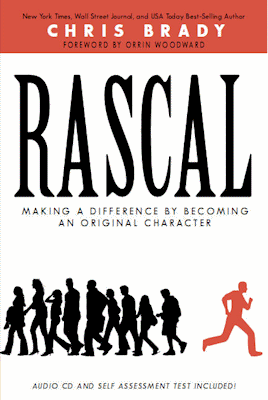 I want my kids to know what a “rascal” is–at least the way Brady defines it. I want them to be the kind of people this book promotes, and I can’t wait for them to ask me about this book.
I want my kids to know what a “rascal” is–at least the way Brady defines it. I want them to be the kind of people this book promotes, and I can’t wait for them to ask me about this book.
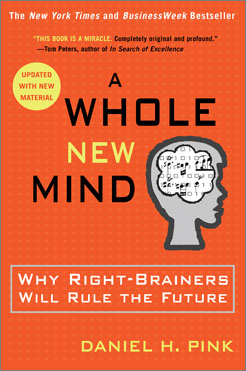 A Whole New Mind, by Daniel Pink
A Whole New Mind, by Daniel Pink
I want my youth to be innovative, creative, and have initiative. This is one of the hardest things to teach, but I’ll look for opportunities to discuss these things as I read this book.
Isaiah, in the Bible
I love sharing scriptural verses with the kids and discussing the meanings and lessons. It leads to a lot of important conversations with the kids about the most important topics.
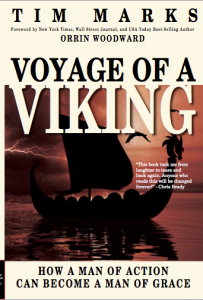 Voyage of a Viking, by Tim Marks
Voyage of a Viking, by Tim Marks
I can’t wait to talk to my kids and youth about this book! It’s about seeking for greatness, learning from your mistakes, not settling for mediocrity, and constantly improving yourself. I know the title of this book will have all my kids asking me questions about it!
Chillin’ and Grillin’
This week I’ve been reading these books in the evenings outside by the grill and the court where the kids play basketball, in the hot afternoons near the swamp cooler, and in the kitchen before meals and during cleanup after the family eats. I’ve taken turns with each book, so I’m a few chapters into all five of them, but I’ve had more than one discussion about each with the kids.
Tonight as dinner started, I got everyone’s attention and said, “I’m reading this awesome book. Actually, I’ve read it before but I’m re-reading it and I want to share something from it that really touched me.”
Everyone quieted down and listened. “Here goes,” I said. Then I read from Voyage of a Viking:
Kids can be pretty relentless in teasing one another, and the kids in my school were no different. I had never before been the subject of teasing and bullying, so it was a new experience for me. You see, news of my parents’ divorce got around town pretty quickly, and it wasn’t too long before the news hit my schoolyard.
The little kids in the family were leaning forward at full attention, and even the teens were paying close attention. I kept reading:
And then the teasing began. ‘There’s Tim, and he doesn’t have a dad,’ the kids would whisper to each other and taunt me.
I stopped reading and asked, “How would that make you feel?”
“I’d hate it!” Meri said forcefully. The other kids agreed.
After they shared their feelings, I asked, “Have you ever been teased like that?” We discussed this for a while, then I asked everyone, “Okay, I have another question. Have you ever teased anyone this way?”
“No way!” Meri exclaimed. She is nothing if not earnest.
“Are you sure?” I asked slowly.
Everyone considered. “Well, actually,” Meri said, then she told several stories of when she wasn’t very nice to people in her life. The other kids shared too, and we had a great conversation about being good friends and also standing up against bullying even when the victim isn’t your friend.
When I read what happened next in the book, everyone got even more interested. You’ve got to read it to get it! We spent dinner talking about this and discussing it.
At the end, I said, “I’m so excited to read the rest of this book.”
“Me too,” America said emphatically. “Meri” is nine years old, and she loves to read. I don’t know when she’ll read Voyage of a Viking, but I’ll be sharing from it and the others on my list all summer.
Actually, I’m having a hard time reading it because after our dinner discussion my visiting twenty-year old daughter Sara borrowed my copy and is reading it. Oh well, she reads fast. In the meantime, I’ve got the other four books.
Tomorrow at breakfast I’m planning to share the following quote from Livy, where he says that he is excited to write about Rome because, as he puts it:
I shall be able to turn my eyes from the troubles which for so long have tormented the modern world.
I’ll ask the family, “Why do you think people always feel that the modern, current world is so chaotic and hard and that the people in history somehow had things more simple? I mean, Livy thought this clear back in the time of Jesus Christ.”
This question is more for the teenagers, while yesterday’s conversation was perhaps more accessible to the younger kids. But everyone takes part in all of it. The older ones (me included!) bear reminding about Core Phase issues, and the younger ones benefit immensely by being including in the discussion of “serious” topics of academic and intellectual interest.
I could go on and on sharing examples of how to do this, but I’ve got a book calling to me. I’ve finished work for the day, and I want to read in the yard this evening—so I’ll be near the kids and we can talk.
Maybe I’ll teach them from one of these five books I’m reading, or maybe Meri will bring me a book of her own to read and talk about. Or perhaps we’ll all just sit in the warm evening and watch the sunset and talk. I often have the stack of all five books around with me, so I can just pick and choose which to read and share.
In any case, I’m excited to keep reading and sharing my book list this summer. This first week has been great. I can’t wait to see what we’ll learn about together in the months ahead.
Summer is a great time for education. So just get out your books, start reading, and share! The impact on freedom is huge.
Also check out Summer Reading for Kids >>
*Most of these books are available at your local library. Or, check the affiliate links to see amazon reviews, etc.
Category : Blog &Book Reviews &Business &Citizenship &Culture &Education &Family &Generations &Independents &Leadership &Liberty &Mission &Statesmanship
Wounded by School (book review)
June 14th, 2013 // 10:13 am @ Oliver DeMille
Another important book about freedom (and the lack of it) in modern education is Wounded by School by Kirsten Olson. It outlines the normal ways in which modern education hurts most children, shows the history of why schools adopt such harmful policies, and suggests real solutions.
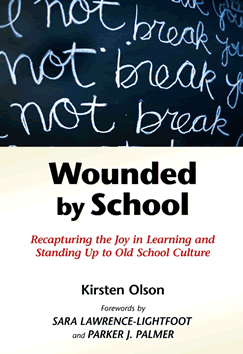 For example, Olson writes: “Many theorists suggest that the purpose of schools is to mold and shape individual self-concept so that pupils will accept a particular place in society…” Is this really what you want for your children?
For example, Olson writes: “Many theorists suggest that the purpose of schools is to mold and shape individual self-concept so that pupils will accept a particular place in society…” Is this really what you want for your children?
On a larger scale, what is the impact on freedom of raising a generation of youth to “accept a particular place in society”? This is a class system, pure and simple.
Olson points out that “Schools are deliberately designed to sort and track” students into order to promote the class system. Olson also suggests that among the key ways modern schools wound students are things like the following:
- I felt sick in school.
- I’m in the middle.
- I must comply.
- I can’t measure up.
- I am better than those below me.
- I must impress my superiors.
- What I want isn’t as important as what my betters want.
- Creativity must be secret—my focus must be conformity.
- Learning isn’t fun.
And for parents: “I feel helpless about saving my child,” and “The experts know what my kids need more than I do.”
Olson’s solutions center around bringing freedom back into schooling. Indeed, this is the focus of a lot of cutting-edge books and research on education.
Above all, we need to be clear about one thing: Freedom works. It does. Freedom is the best choice in society and also in education. If you are a parent or teacher, you have more power than you know. I highly recommend this book.
Category : Blog &Book Reviews &Culture &Education &Family &Leadership











